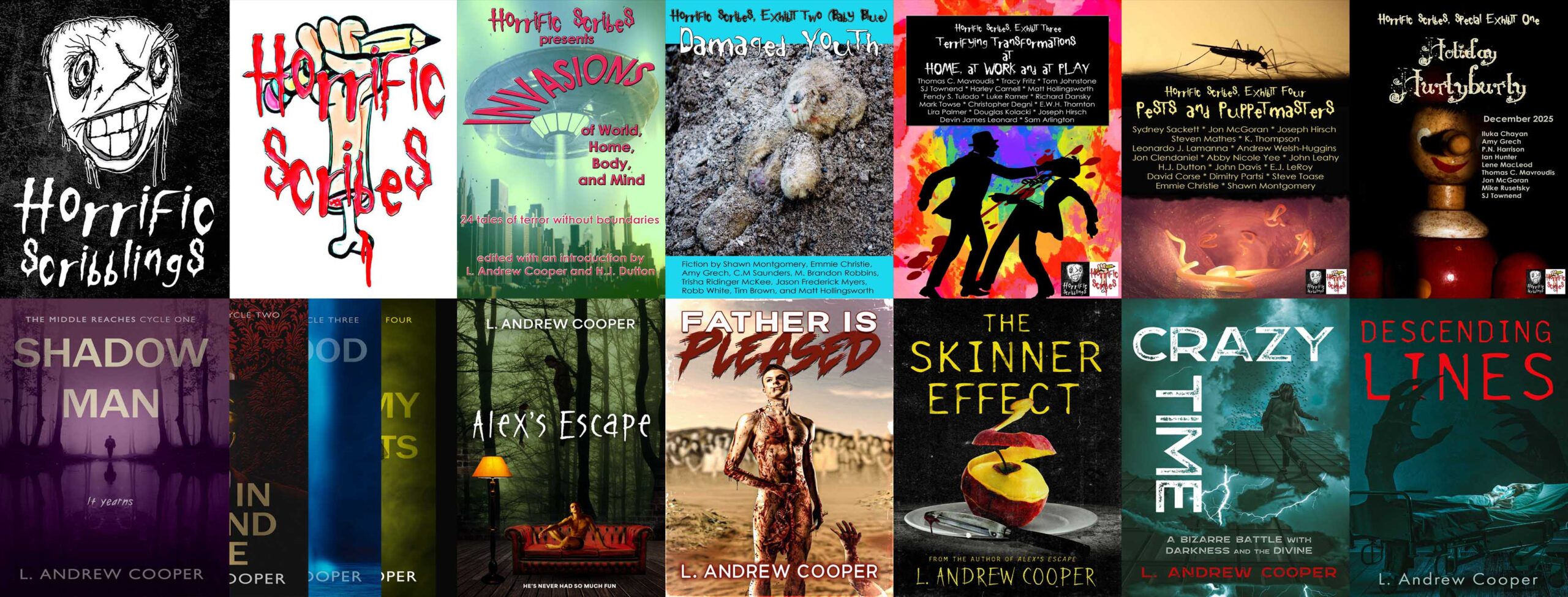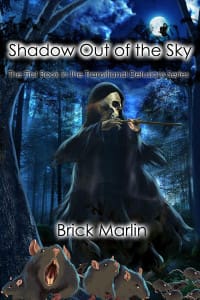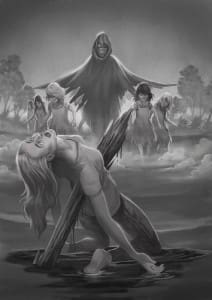Brick Marlin’s Shadow Out of the Sky—a horror novel with enough ingredients from science fiction, fairy tales, and other sources to feed a troop of hungry new readers as well as more world-weary horror aficianados—wants to bring a little extra darkness into your life.
Now that autumn is upon us, and the march to Halloween has begun, so has the parade of scares, so Marlin’s book isn’t alone. The Horror Writers’ Association is about to begin its Halloween Haunts, and we horror writers are moving into high gear. How do you know whether to include this read among your seasonal macabre missions? (Keep in mind that the season doesn’t end with the pumpkins—the early Gothic novels, and many that followed, weren’t for Halloween… the first was published Dec. 24, 1764).
The first answer is, as it should be, fun. Marlin’s book is slender, fast-paced, and idea-packed (read the synopsis, as well as an interview with the author, here). Instead of following cues from the mystery genre, teasing with the premise and deferring explanations of odd events until after they unfold, the book takes an omniscient perspective and offers “history lessons” that allow readers to pity characters who remain unaware of how totally screwed they are. We know early on, then, while characters fumble to grasp that their town’s children have started to change for the worse and take up sharp things that hew flesh, that an ancient evil is rising.
“In all her life she had never imagined a child could be so horrifying.”
– (loc. 621, Kindle version)
The dramatic irony creates pity, dread, and inevitability rather than surprise—emotions more critical to horror. Acknowledging predecessors such as Stephen King (whom he mentions, and whom he echoes, particularly creepy-kid tale Pet Sematary, which moves with similar horrific inevitability), Marlin still goes his own way. Although his story contains twists that will shock, particularly as character arcs develop, Marlin moves through his material with a confidence in his ideas that says he does not need the components of his premise to be surprising for his story’s emotional core to be effective. This confidence, at least for me, translates directly into success at creating true horror.
And what would horror be without some true grue? The second answer to my question about whether to choose this book for your horror-pleasure is just that: it’s not afraid to show you exactly how and where the blades, spikes, and other nastiness hurt.
“Martha’s face and hair caught a crimson spray and brain debris. Her stomach soured.”
– (loc. 1666)
Not for the squeamish, the book isn’t as NC-17 as some horror (the language is more PG-13… the kids don’t swear nearly as much as Gage in Pet Sematary… the sexuality is an R), but those looking for splatter will not be disappointed.
Blood and gore, draws for many horror readers, aren’t the only imagistic attractions for Shadow Out of the Sky. Among Marlin’s most impressive accomplishments are his uses of light and dark—almost required by the title, but he uses them in compelling, even challenging ways. For some characters, the shadows, darkness, and light represent what you might expect, Light and Dark, Good and Evil, a Manichean world view that would cast the book’s conflicts as a manifestation of the eternal struggle between God and demons or the Devil. For others, particularly since darkness wears the face of innocence (children), light and dark blend more quickly into grey (see the interview for Marlin’s views on good and evil in this work). Further—and this point confused me at first—forces both “materialize” out of AND into darkness. “Out of” made sense to me, but I had to figure out how something could merge materially into darkness. Ultimately, darkness becomes substantial in Marlin’s tale, making his language, and his images, unusual and compelling. Light and darkness are tangible in this book, and that’s a feat worth reading.
I’m not being paid or otherwise bribed for this review, and though I recommend the book, I’d be remiss if I didn’t pick a few nits. The biggest potential drawbacks for readers aren’t drawbacks for me—which is to say, if you don’t like reading fiction with horrific violence and such, the book probably isn’t for you. Likewise, if you’re offended by the idea of kids on killing sprees, look elsewhere. My only slow-downs reading occurred because I think the book could’ve used another round or two of edits (keep in mind that I taught writing for many years and am very sensitive). So if occasional typographical problems bother you, or a redundant phrase or two (“malodorous smell” pops up a couple of times), be prepared, but also, try to relax a bit more.
After all, as Marlin shows us, we have plenty more to be afraid of. Look through the peep hole if someone knocks on your door this Halloween. The cuter they are, the harder they bite.



Comments are closed.